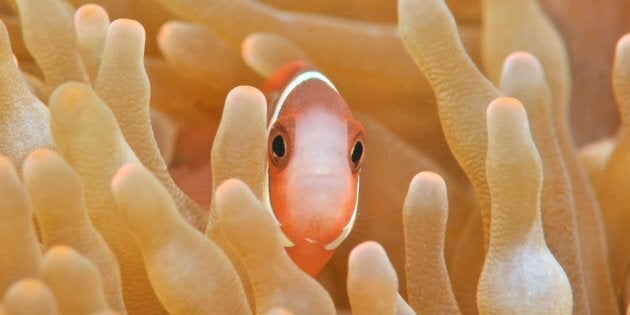

If you want to get up close and personal with a white tip shark, share the water with a turtle, swim alongside dwarf minke whales or watch a manta ray glide by -- there's no better place in the world to do it than Queensland.
The Great Barrier Reef stretches over 2300km and is home to over 1500 species of fish -- ranging from tiny bait fish to some of the world's largest sharks. Here are some of the awe-inspiring creatures you can find, and where and when to get the best chance of sharing the water with them.
Whales
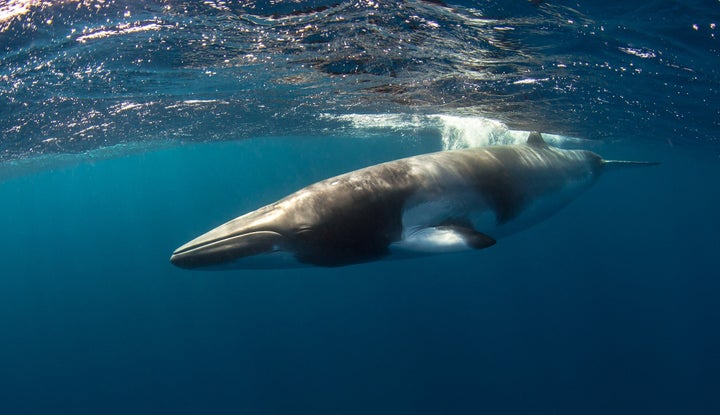
"Dwarf minke whales visit the ribbon reefs in the Northern Great Barrier Reef each austral winter, and it's the only predictable aggregation of them in the world," social-environmental scientist at Great Barrier Reef Marine Park Authority and CSIRO, and photographer at Tethys-images.com, Dr Matt Curnock said.
June and July are the perfect months to spot Minke Whales in Tropical North Queensland. Fly into Cairns and visit Mike Ball Expeditions or Eye To Eye Marine Encounters to book an intimate expedition.
Curnock explained that these type of tour operators lower you in to the water on a safety line, where you wait for the whales to approach you.
"They are the friendliest whales on the planet. They seek out people, and are very curious and sociable. Swimming with them is one of the greatest wildlife spectacles you could imagine," Curnock said.
This photo was taken at Lighthouse Bommie, a dive spot on the southern end of Ribbon Reef No.10, which sits around 200km north of Cairns.
Turtles
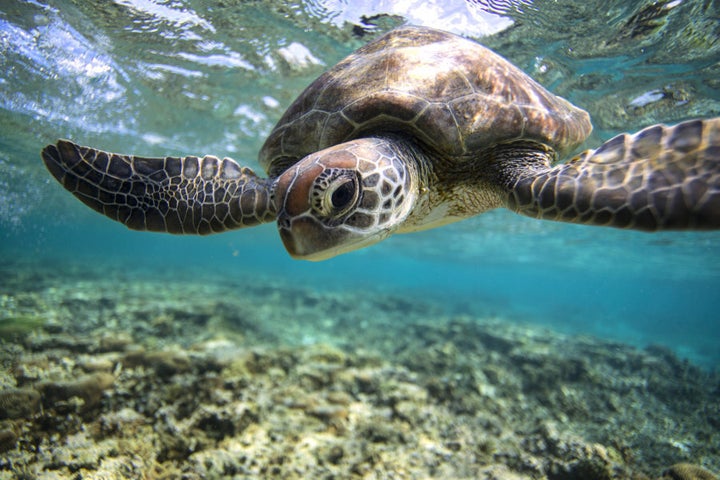
"You can see sea turtles all year round, off nearly any of the Barrier Reef Islands," said lead academic in the scientific programme, Turtles in Trouble, Dr Kathy Townsend.
"It's a special experience being in the water with turtles as they are very gentle, gracious creatures."
If swimming with turtles wasn't enough, at Mon Repos on the Bundaberg coast you can experience the sight of thousands of baby turtles hatching from their eggs and scuttling towards the ocean, as the mother turtles look on.
"This is a big nesting area for loggerhead turtles between November and January," said Townsend. "Be careful not to disturb them as they come up the beach -- even a torch can scare them off back in to the ocean. Sit and watch from a distance."
In Bundaberg, stay at the beautiful beachfront Manta Bargara Resort and head to Lady Musgrave Island for a Lady Musgrave Experience day trip. You'll get to snorkel, swim and eat locally sourced grub.
Sharks
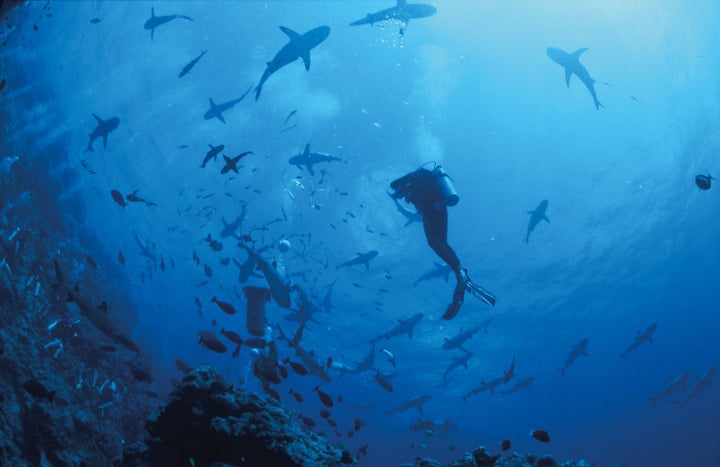
Sharks get a bad rap, but don't forget there's more to this species than great whites, and very few experiences as exhilarating as spotting one.
"These grey reef and white tip sharks are just some of the sharks you can see on the Osprey Reef," said Curnock of the sharks in this photograph by Ben Southall of bestlifeintheworld.com.
"You can also spot silvertips, the occasional tiger shark and sometimes the rare dusky shark too. They're here all year round as the habitat is wild -- it's in really clear, deep water where two currents meet."
Northeast of Cairns and Port Douglas by some considerable distance, the Osprey Reef is best seen via an expedition on a liveaboard boat such as Mike Ball Dive Expeditions. "This keeps diving here very controlled," explained Curnock.
"By doing baited feeds the sharks' behaviour is predictable, so divers can sit and watch them swim around them. It's not scary -- sharks aren't dumb animals -- they know the difference between food and divers."
The liveaboard boats offer scenic flights over the reef back to dry land on Lizard Island. Stay at the secluded Lizard Island Resort and visit the internationally recognised research station which conducts research on coral reefs.
Maori Wrasse
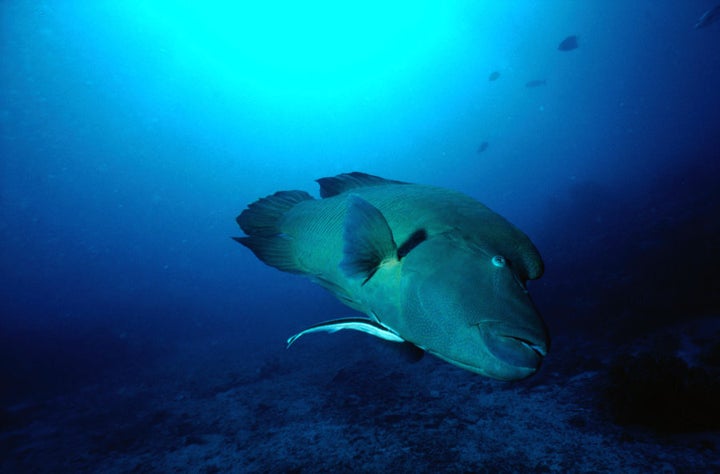
"Maori Wrasse are elusive fish but when you do spot one, it's special to be in the water with them as they are so big," Director of Marine Life at Sea World Gold Coast, Dr Trevor Long said.
"Wrasse like to settle on one reef, so if you see one, don't approach it as this can cause them move away from the area."
They are visible all year round and generally spawn in October, with aggregations of 200 - 300 of them not uncommon.
"You can see Wrasse all over Queensland," Long said. "Many tourist sites set up small stations to feed Wrasse so people can dive with them close to the coast."
Try the Whitsundays -- Hook Island is a great place to snorkel and spot wrasse all year round. Set up camp at one of the island's great beach-side camping spots; Steen's Beach, Maureen's Cove, Crayfish Beach and Curlew Beach -- so you can watch the sunrise over the sea before heading underwater to explore!
Manta Ray
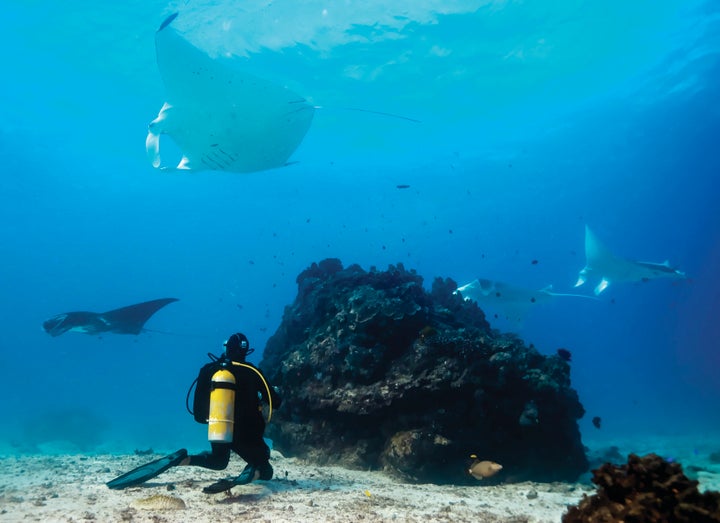
Huge, gentle Manta Rays can be seen off Lady Elliot Island, Heron Island and Lady Musgrave Island throughout the year, and as this shot by Ben Southall of bestlifeintheworld.com proves, these breathtakingly beautiful creatures really are worth seeing for yourself.
"There's a seasonal aggregation of Manta Rays during the winter months around Lady Elliot Island, where they come to the cleaning station and get cleaned by smaller fish," says Curnock. "It's amazing to sit on the ocean floor underneath them. They are very inquisitive if you stay still and aren't erratic."
Fly into Gold Coast or Bundaberg airport and then take a short plane or boat ride to your island of choice. If you choose Lady Elliot Island, the low-key Lady Elliot Island Eco Resort is the perfect base for snorkelling or diving. When you're there don't forget to look for other wildlife -- the secluded island is a significant seabird breeding site.
Clownfish

Extremely cute and popularised by the movie, spotting your own Finding Nemo is one of the great pleasures of the reef.
"Clownfish can be seen as far down in Queensland as reefs off the Sunshine Coast such as Mudjimba (Old Woman) Island," said Curator at SEA LIFE, Kate Willson. However, they can be seen all across the GBR.
It's important that you float gently over the anemone they live in, or they'll hide in the centre of their underwater home -- as seen in this shot by Johnny Gaskell.
"They're around all year long because once they find an anemone to live in, they feed around their habitat and don't move from there. If you get too close or move quickly they will hide in the anemone and wait until you leave before popping their heads out, so move slowly in order to spot one. Never touch an anemone -- they will give us a nasty sting."
If you want to spot Clownfish further north, try Green Island, which is 45 minutes away from Cairns in a catamaran.
Find out more in Queensland's eBook 'In search of Queensland's Great 8'.